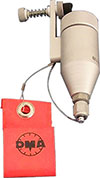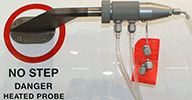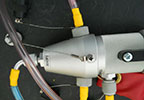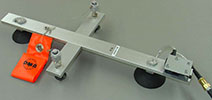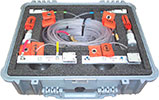Pitot-static Testing and the Role of the Probe Adaptors
As a designer and manufacturer of precision, high accuracy pitot-static test instrumentation, DMA – Aero are acutely aware of the significant role that the junction between the test equipment and the aircraft plays in ensuring a viable test system. The aircraft mounted pitot static probes for the sensing of the aerodynamic values of altitude, airspeed, rate of climb and other related parameters are the commonly used connection points for the ground support test instrumentation.
The design and construction of the pitot static test adaptors that can be installed onto the probes to enable the air data parameters generated by the air Data test Set (ADTS) to be faithfully transmitted to the flight-deck instruments calls for a full understanding of all the requirements to be considered.
Airframe mounted probes are basically designed to provide the best possible results for sensing the air data parameters. The pitot static probe adaptors that will be used to fit onto the probes must accept that the probe design is first and foremost for the aircraft and the adaptor must somehow contend with the vagaries that exist.
It is imperative that the pitot static tube adapters do not in any way damage the pitot-static system. The whole air data test system needs to be able to simulate the appropriate values of pressures and vacuums corresponding to the desired altitudes and airspeeds etc. The mounting of the pitot and static adaptors, and the relevant hoses forming the whole of the assembly onto the probes must not result in any damage to the aerodynamic contour or surface finish nor impose any undue stress loading that could potentially result in misalignment of the probe.
Additionally there needs to be certainty that the particular adaptor sealing method employed does not in any way result in material from the sealing media becoming loose and entering the probe causing blockages.
Since the tests called for on modern aircraft specify air data values to be of extremely high accuracy, for example to meet the requirements -”Reduced Vertical Separation Minima, (RVSM), there must be absolutely minimal leaks in the overall system. This includes all pitot static test connections and pneumatic fittings employed at the adaptor, the hoses to the air data test set (ADTS) and the ADTS panel mounted connectors. A leaking system would result in the observed value on the ADTS not being the received value at the aircraft, thereby negating all the precision so carefully engineered into the ADTS.
The types of probe or sensing point on the aircraft fuselage presents the pitot and static test adaptor designer with a challenge to enable the best result to be achieved to ensure a practical solution. Single pitot probes / tubes allow fairly straightforward sleeve style pitot test adaptor solutions to be used with minimal concerns regarding datum points for the fitting depth. However if the probe is a combined pitot and static variety then the pitot static test fittings must ensure that the static hole in the probe is exactly in line with the adaptor matching connection. Some form of mounting reference needs to be provided to ensure correct placement of the pitot static connectors.
This reference feature becomes particularly important if the probe is even more complex as in the instance where the probe also serves as an Angle of Attack (AoA) sensor. Where the traditional vane form of AoA measurement has been replaced by pneumatic sensing incorporated into the pitot static probe then there are multiple static ports in the probe to which the adaptor must interface.
Static measurement ports on the aircraft fuselage present another challenge for the connection point for the ADTS. Now the adaptor must be so designed that it surrounds the sensing hole in the flat plate of the sensing port. The method employed needs to be both practical and again cause no damage to the static plate, remembering not all aircraft provide mounting features.
The adaptor must include some sensible feature to achieve the desired result. Various methods are used, some more attractive than others. DMA-Aero utilise rubber suction cups to clamp the adaptor onto the plate surface, providing a vacuum source from the MPS range of air data test sets to ensure a firm fixing of the adaptor. Some systems employ the actual sensing hole as the fixing point but this risks damaging the contour of the static point.
For commercial aircraft there are generally multiple probes fitted to allow independent systems for the Captain and the 1st Officer and also generally a Standby channel. In these situations the pitot static test kit manufacturer supplies complete kits that provide all the relevant air data test adaptor kit and the hoses and interconnecting pneumatic fittings for the whole aircraft since the testing of the various parameters is often carried out simultaneously, the ADTS supplying the necessary altitudes, airspeeds etc to all the systems.
The air data accessories kit must also include a static blanking adaptor and a pitot tube dummy adaptor blanking feature to allow the whole air data test adaptor kit to be itself leak tested before installation onto the aircraft.
When such multi probe systems are being catered for then the overall air data accessories kit will be housed in suitable cases / boxes giving the Operator all the equipment needed. These Kits will have been so designed to match the needs of individual aircraft, not only to provide the correct adaptors but also to ensure the appropriate lengths of the hoses do stretch to the remotest aircraft measurement point, often resulting in very long hoses. The hoses selected will have been verified as being suitable for the flight-line environment being rugged and not adversely affected by exposure to fluids such as Skydrol hydraulic leakage that can be a problem in the flight-line working environment.
The complexity of these numerous hoses is alleviated by colour coding the different lines and by utilising self coloured material that is also transparent so that it additionally proves beneficial in that any contamination of the internal pitot-static lines can readily be seen. Using lightweight hose material helps enormously in the overall handling of the complete kit assembly and additionally reduces loading on the installed adaptors.
Since the Adaptors will most likely be in service for many years it is important that the sealing features of the design are capable of being replaced by the operator. Consequently the use, in the design, of readily available commercial “O” ring seals are adopted by DMA as a sure way of allowing ongoing straightforward replacement. The seals become damaged when not installed in a correct manner, and on occasions when the probe heaters are inadvertently turned on by error and the seals damaged as a result.
A very wide range of different Adaptors need to be available for the vast range of aircraft and DMA are constantly introducing new designs to meet new aircraft needs.


